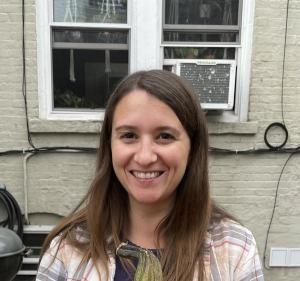This student story was published as part of the 2023 NASW Perlman Virtual Mentoring Program organized by the NASW Education Committee, providing science journalism practice and experience for undergraduate and graduate students.
Story by Hanwen Zhang
Mentored and edited by Laura Dattaro
One of Puerto Rico’s longtime reptilian residents is facing new demands for survival—and taking it all in stride.
Researchers studying the Anolis cristatellus—a common tropical lizard settled throughout Puerto Rico—collected 96 lizards from forested and urbanized habitats in Arecibo, Mayaguez, and San Juan and sequenced their genomes. What started as a survey of the lizards’ body traits uncovered something unexpected along the way: parallel shifts in genome expression across the urban anoles that could show how animal populations are responding to our expanding human presence.
“You start to find unpredictable things that might be associated with adapting to these different environments,” said study investigator Brian Verrelli, VCU professor of biological data science.
A first comparison between genomes of urban and forest anoles revealed the far-reaching impacts of city life. Genes for immune functions, such as wound healing and skin development, were overexpressed among the urban groups, suggesting the lizards deal with more physical onslaughts than their forest counterparts. Sequences related to neural function, pigmentation, and metabolism were also being more actively transcribed.
But the morphology-related sequences gave the researchers pause. When identifying limb-related loci through genome-wide association studies, they discovered that many of those same urban anoles had mutations in genes associated with skeletal-muscular disorders in humans and mice compared to those found in the forest. In other words, the lizards had tweaked otherwise pathological gene sequences—an entire set of them—into a boon for survival.
The finding “suggests that the kind of selective landscape really matters,” said lead author Kristin Winchell, herpetology professor at New York University. Tinkering with sequences like these can produce devastating consequences for the animals, she explained, but it can also unlock dramatic and rapid changes. It is an evolutionary gamble: doomed if done wrong but radically beneficial if it happens to meet the right environmental context and genetic background.
Despite being genetically separate from each other, all three urban anole populations also had significantly longer forelimbs and hindlimbs compared to their forest-dwelling counterparts. Ditto for their larger toe pads and density of lamella, the scaly plates on the undersides of their toes that help them cling to surfaces. The urban anoles seem to be making nearly identical adaptive journeys, even if they were entirely independent from each other.
It’s a real-life case of town mouse meets country mouse. Even though their genomes may be more closely related to their local forest counterparts, the urban lizards are actually “adapting to those cities in similar ways,” said Verrelli. Confronted by similar environmental pressures, the three urban anoles arrived at morphological features that overrode some of their intrinsic genetic differences.
Cities allow scientists studying climate change to substitute space for time, Winchell said. With our urban areas acting as laboratories that simulate the effects of climate change, they allow scientists to observe what the ecological landscape might look like years from now. By that logic, animals already adapted to cities would be the ones most likely to survive. Urban anoles are both a reflection of our urban footprints and a firsthand preview of our future world.
Winchell next plans to study the Anolis stratulus, a species that has adapted to the same urban environment as their distant cristatellus relatives but restricts itself entirely to greenspaces in the city. Comparing the two species will enable Winchell to study how their strategies for handling hotter temperatures might differ.
The effects of climate change might be felt differently for the lizards—depending on niche and geography—but the urgency of its selective pressure will be the same, wrote Kevin de Queiroz, a Smithsonian anole researcher who was not involved in the study. “Some species won’t be able to adapt and will become extinct,” de Quieroz continued. “Others will shift their geographic distributions to places with more favorable climates […] and those that remain will be under natural selection to adapt to the warmer temperatures.”
Across the planet, anoles and others will have to accommodate ever-warmer weather with whatever mutations, traits, or behaviors might help them get by. Rapid evolution—in which populations change certain traits across comparatively short timespans—is becoming more common, said Manuel Leal, University of Missouri evolutionary ecology professor, who was not involved in the study. Beyond adaptive limbs, for instance, urban anoles are already changing their activity schedules: “You go out in the middle of the day, and Anolis cristatellus is basically not active,” he said.
If the anoles are now confronted with demands for change, they also continue to offer us lessons in constancy. They’re native to Puerto Rico and have been research subjects as far back as the 1800s, according to Winchell. They persisted even as the region rapidly urbanized in the mid-1900s—during which roughly 5% of original forest remained—and today, as it undergoes a wave of reforestation and record-breaking heat. This June, temperatures in the region soared as high as 125 degrees Fahrenheit.
Urban spaces don’t exert the same selective influence on us as they do lizards, but they’ve certainly impacted our lives: noise, light pollution, and decreased access to green space all affect mental health. Heat and humidity are mounting health hazards. Running a comb through the genes of our urban cohabitants helps us understand the “health and well-being of humans in cities,” Winchell said.
“No matter what phenotype you look at,” Winchell said, “it’s probably being altered by living in this human landscape.
Main image caption: The Anolis cristatellus has been around Puerto Rico for as long as the island itself. They’re facing unprecedented challenges in the face of urbanization, but have developed unique strategies to overcome them. Image credit: Postdlf via Wikimedia Commons.
Hanwen Zhang is a student at Yale University majoring in English and ecology and evolutionary biology.
The NASW Perlman Virtual Mentoring program is named for longtime science writer and past NASW President David Perlman. Dave, who died in 2020 at the age of 101 only three years after his retirement from the San Francisco Chronicle, was a mentor to countless members of the science writing community and always made time for kind and supportive words, especially for early career writers. Contact NASW Education Committee Co-Chairs Czerne Reid and Ashley Yeager and Perlman Program Coordinator Courtney Gorman at mentor@nasw.org. Thank you to the many NASW member volunteers who spearhead our #SciWriStudent programming year after year.
Founded in 1934 with a mission to fight for the free flow of science news, NASW is an organization of ~ 2,600 professional journalists, authors, editors, producers, public information officers, students and people who write and produce material intended to inform the public about science, health, engineering, and technology. To learn more, visit www.nasw.org






